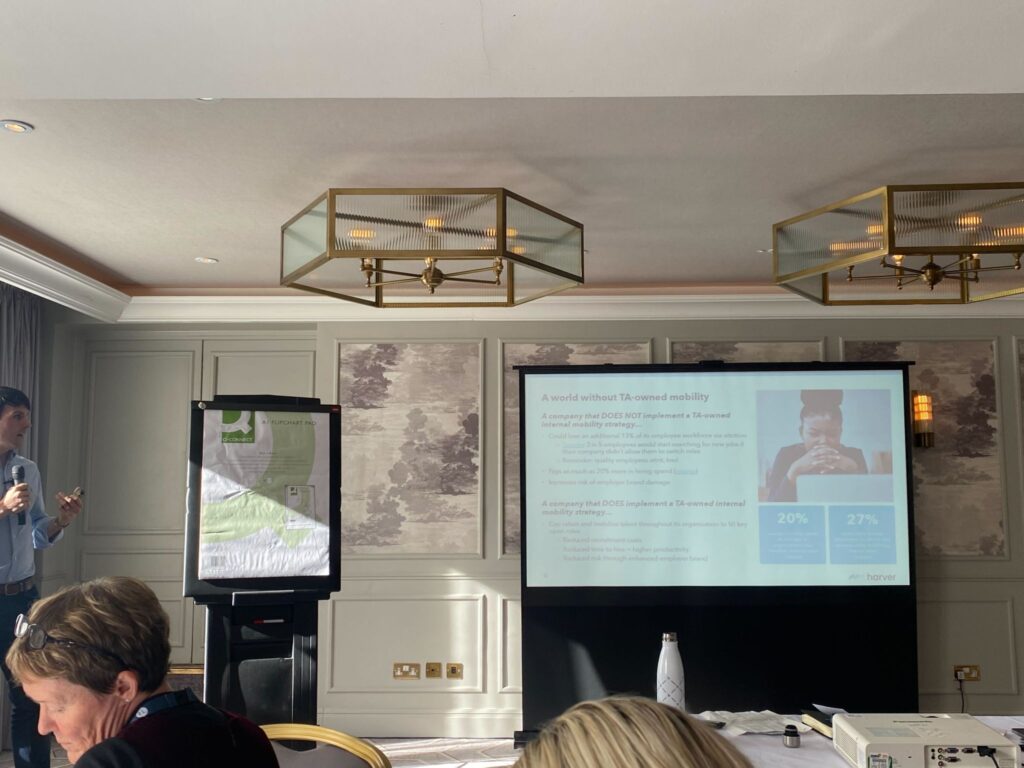Recently I had the pleasure of joining over 30 talent acquisition leaders in Stratford-Upon-Avon for what turned out to be yet another fantastic RL100 Summit.
Held at a stately country house set in the birth town of William Shakespeare, the summit allowed my industry counterparts and me to engage in some much-needed talent lifecycle “group therapy.” For two days, we discussed the largest workforce challenges we are currently facing and how we might overcome these.
Amongst all the learning, brainstorming, and networking that took place, I took note of the most prominent and commonly mentioned themes stemming from the event:
Internal mobility is a top priority for talent acquisition professionals in 2023. On day one of the summit, I ran a session called “Make Do and Mend: Why TA Must Take Ownership of Internal Mobility in 2023.” In it, I explored why TA-owned internal mobility strategy is vital for organisations. This is not only to react to the challenges presented by today’s tight labour market (and tightening acquisition budgets), but also make better external hiring decisions altogether. What was affirming to me is that many of the TA leaders in the room agree that now is the moment that TA needs to take control and be the primary agent in enabling internal mobility.
One element I explored with the group was the opportunity for companies to create a ‘soft skills taxonomy’ by measuring their existing workforce for their behaviours and strengths to support in the identification of development pathways and internal job moves. Adopting a consistent method of assessing both candidates and employees provides the opportunity for feedback loops and better talent decisions.
Data is becoming an increasingly large part of talent acquisition’s world – and those that are building out and hiring for data analytics functions within their organisations are those who are enhancing talent acquisition effectiveness.
Using macro employee data, generated from a skills taxonomy or other internal sources, companies can more effectively predict future skills gaps and determine where they can repurpose skills internally versus going to the external market A [PC1] presentation on workforce planning detailed how one company leverages data from LMS, HRIS and performance management systems alongside written employee profiles to taxonomize their workforce, for example.
The goal isn’t to replace human-led talent decisions with automation – it is to enable more informed talent decisions with science-backed data. Getting the right data in the right hands within your acquisition team allows for informed human-driven talent decisions.
Skills shortages and attrition continue to plague many industries. The onus is on organisations to not only identify opportunities for reskilling and upskilling, but also look beyond resume/CV staples like experience and measure one’s potential to grow within a given role.
The skills shortage, paired with attrition rates that are collectively costing organisations trillions, reinforces the need for a data-driven approach, in which companies can assess strengths and weaknesses for candidates and employees alike. Traditional assessment methods allow for more historical upskilling and reskilling opportunities, while soft skill assessments can help determine if even though a particular employee hasn’t mastered a specific skill at a certain point in time, they have to potential to step into a new role and learn new skills. This ability to hire candidates or mobilize employees based on potential can be crucial when filling vital job functions on strained talent budgets.
Improving the candidate experience is an ongoing battle. One delegate offered up the concept of a “psychological contract” that companies sign when they hire employees. In other words, employers set expectations for the employee experience throughout the hiring process and subsequent employment, based on how they market their brand and engage people. That contract is constantly updated – expectations are first set by the career site one applies from, or the referral one receives. From there, what one sees during the recruitment process sets new expectations, and so on.
The prevailing sentiment is that talent professionals must be transparent in communicating a clear picture of company values and what the experience will be like within a given role. If these expectations are not realistically set, employees will quickly grow disillusioned and look for a better experience elsewhere. Companies must invest in an employer brand that is employee-centric and build a more positive reputation.
There is a continued and concerted effort to navigate post-pandemic work environment structures. Is there value in bringing everyone back into the office? How does a company successfully implement a full-scale return to office? Can it be reversed?
We are now three full years removed from the onset of the COVID-19 pandemic, and companies are still actively working to determine what ratio of in-office to remote work is best for them.
So, in-office or remote? The truth is, for many the cat is out of the bag. Those organisations that want to reverse work from home flexibility will need to accept that this will lead to some attrition – in what is still a tight labour market, TA is hoping these directives won’t be made lightly or without proper forward planning.
As I reflect on this RL100 Summit (and eagerly await the next!), it’s clear that in a year where companies are forced to do more with less, organisations are forced to take further stock of where the gaps lie in their talent acquisition and talent development approach. My advice? Those looking to improve upon quality and speed of hire simultaneously would be wise to first look inwards.
Interested in learning how we can help your organisation make better talent decisions across the entire talent lifecycle? Let’s connect!


